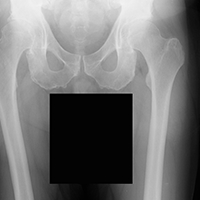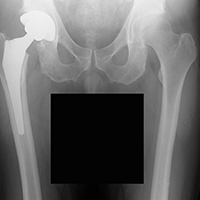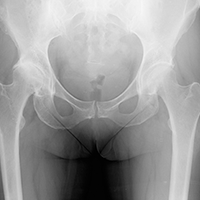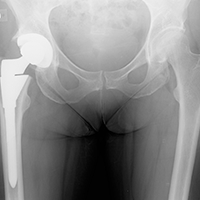Hip Replacement
The hip is a "ball-and-socket" joint where the "ball" (the femoral head) at the top of the thigh bone (the femur) fits inside the "socket" in the pelvis (the acetabulum). A layer of articular or hyaline cartilage covers the femoral head and lines the acetabulum, to allow smooth and painless motion of a healthy hip. The joint is also lubricated by synovial fluid- a viscus fluid (similar to 10W-30) produced by all joints in the body.
When the bone and/or cartilage of the hip becomes diseased or damaged from arthritis, hip fractures, bone death or other causes, the joint can stiffen and be very painful. A total hip replacement may be recommended for patients who experience severe hip pain and whose daily lives are significantly affected by the pain. Total hip replacement involves replacing the diseased bone and cartilage with metal (usually titanium) and plastic (polyethylene) to relieve pain and restore movement and function to the joint. After this procedure, patients will be able to once again move without the stiff, debilitating pain of arthritis. During a total hip replacement, a minimally invasive approach is used to access the joint. This allows removal of the damaged bone and cartilage ends and the ability to replace them with the prosthetic joint. The prosthesis is usually a "cement-less" design, meaning that the prosthesis is designed to allow the body to form a permanent "bond" between the bone and the prosthesis. In patients with severe osteoporosis or soft bones, the prosthesis may be cemented in place. Dr. Kaper will determine which technique is best for your individual condition during a pre-surgical consultation. The surgery is typically performed under a combined spinal and general anesthesia and lasts approximately one hour, followed by 60-90 minutes spent under observation in the recovery room (also known as the PACU). New technology has allowed for certain minimally invasive techniques to be employed during the hip replacement procedure. Patients can benefit from shorter recovery times and less scarring with minimally invasive total hip replacement.
http://www.smith-nephew.com/patient/treatments/hip-treatments/hip-replacement-procedure/
Direct Anterior Hip Replacement
The history of Total Hip Arthroplasty (THA) surgery dates back almost 100 years. Since the introduction of the “modern” hip replacement surgery by Sir John Charnley in England in the 1960’s, the evolution of this surgery has been unparalleled in medicine. Technological advances, coupled with technique advances, now allow orthopaedic surgeons to perform hip replacement with reliable and consistent results, proven by decades of scientific research.
No one prosthesis or technique can truly be claimed to be clearly superior to another. However, there are trends in hip replacement surgery that are proving to lead to long-term success with a shortened recovery time for patients. One of these advances has been the use of the Direct Anterior (or DA) Total Hip Arthroplasty. This surgical approach, while practiced by a small number of orthopaedic surgeons since the 1970’s, has been gaining popularity with the regular use of specially designed operating room tables that facilitate the ease of the surgery procedure. There are now several operating room tables specifically designed for the DA – THA approach, including the HANA® table, which Dr. Kaper now routinely uses for hip replacement surgery.
The DA hip replacement surgery is performed through a small, usually 3 ½- 4 inch, incision on the front of the lateral thigh. The size of the incision is certainly not the most important concern. What the DA –THA allows is a “tissue sparing” or “less traumatic” approach to the hip joint itself- meaning less potential trauma to the muscles and tissues around the hip joint in the process of the surgery. By working between the muscles of the front of the hip, Dr. Kaper is able to replace the hip joint with far less trauma than was previously possible. Surgery will typically take about one hour and patients are able to get up, out of bed within several hours of surgery.
Many patients are now able to have their hip replacement on an outpatient basis. This means that they go home the day of their surgery. If there are any medical issues that require post-operative monitoring, a patient may require a one night stay in the hospital.
The potential benefit to the patient is an earlier and speedier recovery with (hopefully) less pain and disability. Several recent studies have proven the superiority of the Direct Anterior approach. One specific risk of surgery is the potential complication of dislocation. A recent study showed that patients needing hip replacement, who also have spinal/low back pathology, have a significantly lower risk of dislocation if there surgery is done with the Direct Anterior approach instead of the traditional posterior approach. https://pubmed.ncbi.nlm.nih.gov/32919847/
There are always individual patient circumstances that may influence the actual surgery and ultimate recovery time – this will be discussed with Dr. Kaper prior to surgery. Please do not hesitate to ask questions or raise any concerns that you may have about the surgical care.
Direct Anterior Hip Replacement Protocol
To achieve the desired result of a less-invasive hip replacement surgery, Dr Kaper follows a specific protocol, that starts prior to surgery and continues both during and after surgery. This protocol includes:
- Pre-operative physical therapy, also known as “prehab”, for a thorough conditioning program prior to surgery to help reduce joint stiffness and improve muscle function and strength before surgery;
- Pre-operative patient education, with a dedicated “team-approach” to surgery to ensure that the patient will have appropriate education and resources dedicated to them prior to and after surgery to maximize the outcomes of surgery;
- A “multi-modality” pain management approach with pre-emptive medication regimen;
- Meticulous handling of the tissues in and around the hip during surgery to minimize tissue inflammation;
- Careful control of any bleeding during surgery to minimize hematoma formation after surgery;
- Precise placement of the hip prosthesis, with careful attention to implant size, alignment, position and soft tissue balancing of the hip joint;
- #7 Routine injection of longer-acting local anesthetic medications within the hip joint to minimize pain and bleeding after surgery;
- Routine use of medications that help control bleeding during and after surgery - medications known as anti-fibrinolytic agents, known as Tranexamic Acid or Amicar;
- Regular and aggressive use of “cryo-therapy” (a fancy way of saying icing) of the hip and thigh after surgery;
- Early post-operative mobilization with physical therapy to minimize stiffness of the hip joint and the muscles around the hip.
Patient Experiences
Although it is always interesting to read educational material about medical conditions and surgical treatments, sometimes the most helpful information can come from patients who have already experienced it. The following are comments from some of Dr. Kaper's patients who have had the Direct Anterior total hip:
"I was standing and walking within 3 hours of surgery"
"I was able to do the physical therapy-instructed exercises with ease and also with very little discomfort"
"[Compared to the posterior approach], it was a much faster recovery, with much less pain- I was moving more with greater ease"
"Getting to and from a sitting position with very little pain ... and because I wasn't sitting on the incision, it was more comfortable"
Patient Photos

Patient 1 - Pre-operative Right Hip (Front View)

Patient 1 - Post-operative Right Hip (Front View)

Patient 2 - Pre-operative Right Hip (Front View)

Patient 2 - Post-operative Right Hip (Front View)
Pre-operative Medical Evaluation
Prior to any surgical procedure, a medical evaluation is recommended. This evaluation is usually performed by a patient’s primary care physician, arranged in conjunction with our office. Evaluation will include a physical examination, EKG and basic laboratory tests. This type of evaluation will allow us to establish a good picture of a patient’s baseline medical health - and allow us to recommend specific areas that could be optimized prior to surgery.
Occasionally, medical concerns are identified that need attention and treatment prior to surgery. Patients with diabetes are of particular concern. There is substantial research to suggest that diabetic patients are at increased risk for complications. This increased risk can be reduced if the patient is compliant with their blood sugar control. The test of the Hemoglobin A1C (Hbg A1C) is the most reliable test to check on long term blood sugar control. The HgbA1C should be at or below 7 before any elective surgery. If the lab test is greater than 7, it is usually best to postpone surgery to allow the patient to get their sugars under between control. It is certainly not prudent to proceed knowing the risk of complications is higher than necessary.
Obesity is another medical challenge for some patients. Obesity is defined based on a patients’ “Body Mass Index” or BMI for short. A BMI over 40 increases the risk for infection after joint replacement surgery. If a patient is unsuccessful, through a combination of diet and exercise, at losing weight to get their BMI below 40, bariatic surgery may need to be considered.
Patients with underlying lung, heart, kidney or liver problems may need consultation with a specialist in one or more of these areas prior to surgery. Further testing may be needed depending on a patient’s individual circumstance.
Tobacco use is another cause of concern. Smoking have been shown to increase the risk of complications after many orthopaedic surgeries, including joint replacement and spinal surgery. The best advice is for the patient to stop smoking. Help from your primary care physician can be obtained to assist in this goal.
Our goal is to minimize the risks associated with surgery - this includes reducing the medical risks that our patients may be exposed to.
Risks Associated with Total Hip Replacement Surgery
As with any surgical procedure, there are real risks associated with hip replacement surgery - it is still a major surgical procedure. Risks include: infection; dislocation of the hip joint; blood clots (deep vein thrombosis or DVT and pulmonary embolism or PE); fracture around the hip prosthesis; injury to a nerve around the hip which could result in temporary or permanent loss of nerve function; injury to blood vessels around the hip; persistent pain in the hip; loosening of the hip prosthesis; medical complications, such as stroke or heart attack; the potential need for further surgery; As the saying goes, there are no guarantees in life. Complications can and do happen. If a complication were to occur, Dr. Kaper will explain the situation is detail and offer appropriate treatment to address the complication. The younger the patient is at the time of hip replacement surgery, the higher the chance that further surgery may be necessary at some time in the future. Most hip replacement prostheses or implants are designed to tolerate everyday activities for many years. Most long-term studies are showing >90% of hip implants are still functioning well after 15 years. With the ongoing improvement in the prosthetic materials used for hip replacement, it may be that we can look forward to 20-30 years of use from a hip replacement. Please recognize, however, that there truly can be no guarantees in this regard. Dr. Kaper will be happy to discuss the different options, choices and recommendations that he will make in regard to your hip replacement prosthesis.
If you have questions about hip replacement surgery, please call the office at (480)305-0034 to schedule a consultation.
The Economics of Total Hip Replacement Surgery
More and more patients are getting involved with the economic side of medicine- they should since the patient is the ultimate consumer of the healthcare product. Our office strives to be as transparent as possible with regard the cost of my surgical procedures. Surgical procedures are billed through the use of a nationally established set of codes, known as the Common Procedural Terminology or CPT for short.
Total Hip Arthroplasty (THA) is billed as CPT code 27130; Revision THA of the Acetabular component (hip socket) is CPT code 27137; Revision of the Femoral component (femoral stem or pin, and ball) is CPT code 27138; Complete Revision of THA (socket, ball and stem) is CPT code 27134. Although this information can be confusing, knowledge of the codes used is helpful to patients in order to understand the foundation from which surgical billing is determined. Surgeon fees will vary. Often the reimbursed amount is determined by the contract between the surgeon and your insurance company. In addition to the surgeons' fee, additional charges will be incurred in the entire surgical process. These include surgical assistant fee, anesthesiologist fee, hospital fee and physical therapy fee. If you would like to know more or have specific questions about medical costs, please do not hesitate to contact our office billing and insurance specialist.
Guidelines for Prophylactic Antibiotics after Hip Replacement
For routine dental prophylaxis or any invasive surgical procedure, one dose of Keflex or Amoxicillin, 2 grams orally, taken one hour prior to your dental appointment or procedure is recommended.
For patients with allergies to Penicillins, we recommend Clindamycin 600 mg orally.
The recommendation for prophylactic antibiotics is usually in place for 2 years from the time of your joint replacement surgery.



